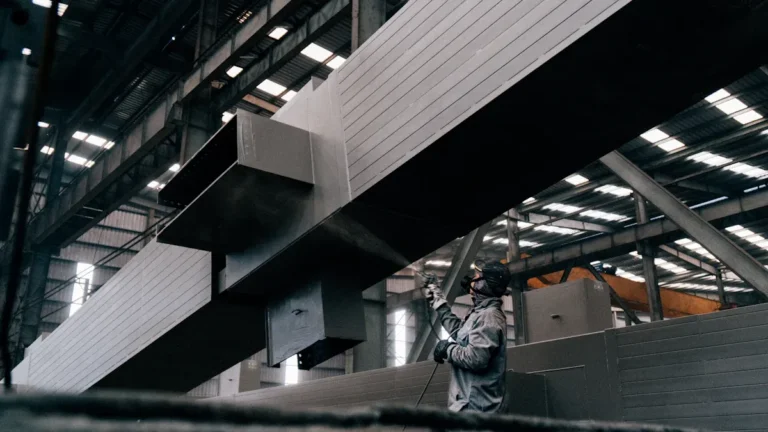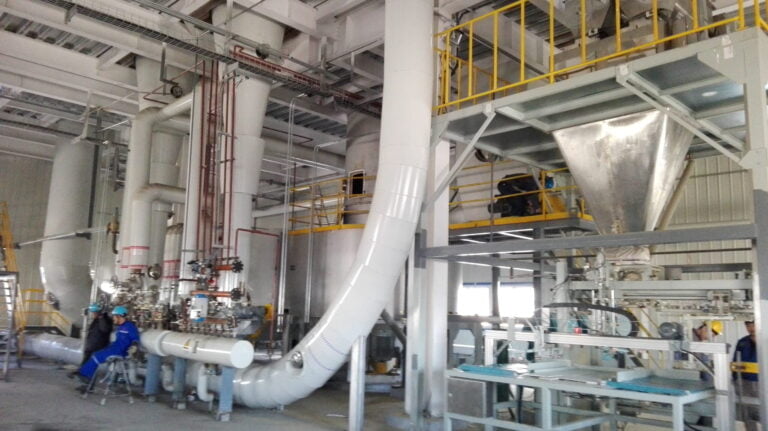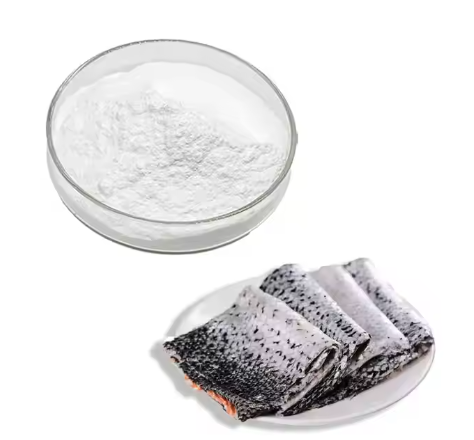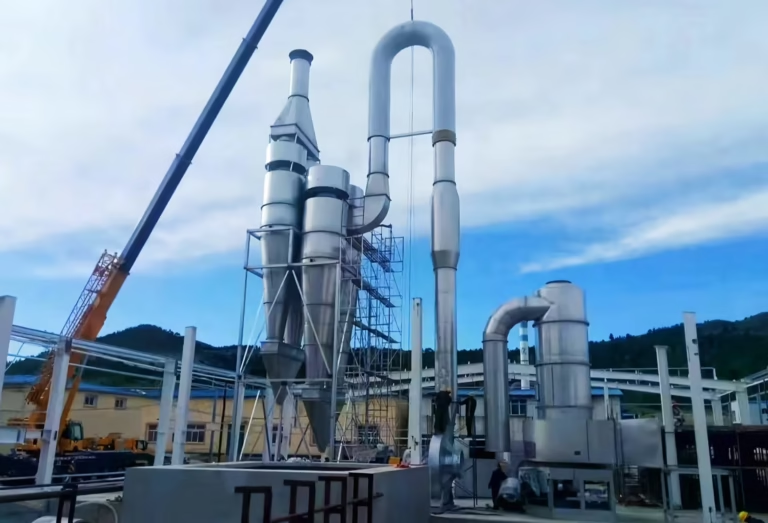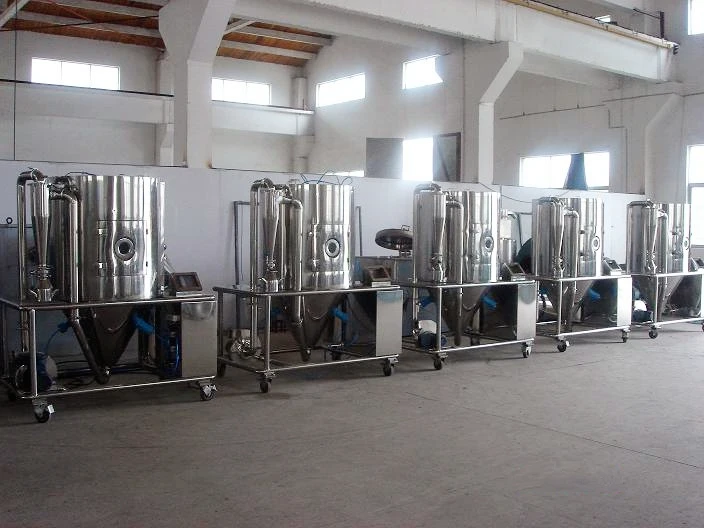Подробный обзор технологии распылительной сушки
Технология распылительной сушки
Распылительные сушилки — это промышленные машины, используемые для превращения жидкостей в порошки или гранулы за один этап.. Жидкость распыляется на мельчайшие капли., и эти капли затем сушат потоком горячего воздуха для удаления влаги.. В результате получается жидкий порошок, который легко транспортировать и упаковывать.. Распылительная сушка широко используется в пищевой промышленности., фармацевтический, и химической промышленности благодаря своей высокой эффективности, адаптивность, и стабильное качество продукции.
История и принцип работы распылительных сушилок
История распылительной сушки
Распылительная сушка была впервые использована французским инженером Алексисом Милларде в 19 веке для создания сухих винных дрожжей для винодельческой промышленности.. Однако, этот процесс не получил широкого распространения до середины 20 века.. Первая промышленная распылительная сушилка была разработана в 1930-х годах.. В первых распылительных сушилках использовались форсунки., и только десятилетия спустя были представлены роторные распылители.. Эта технология имела ограниченное коммерческое использование до 1920-х годов из-за простоты ранних конструкций и эксплуатационных проблем.. Через некоторое время, Технология распылительной сушки развивалась для удовлетворения потребностей различных отраслей промышленности..
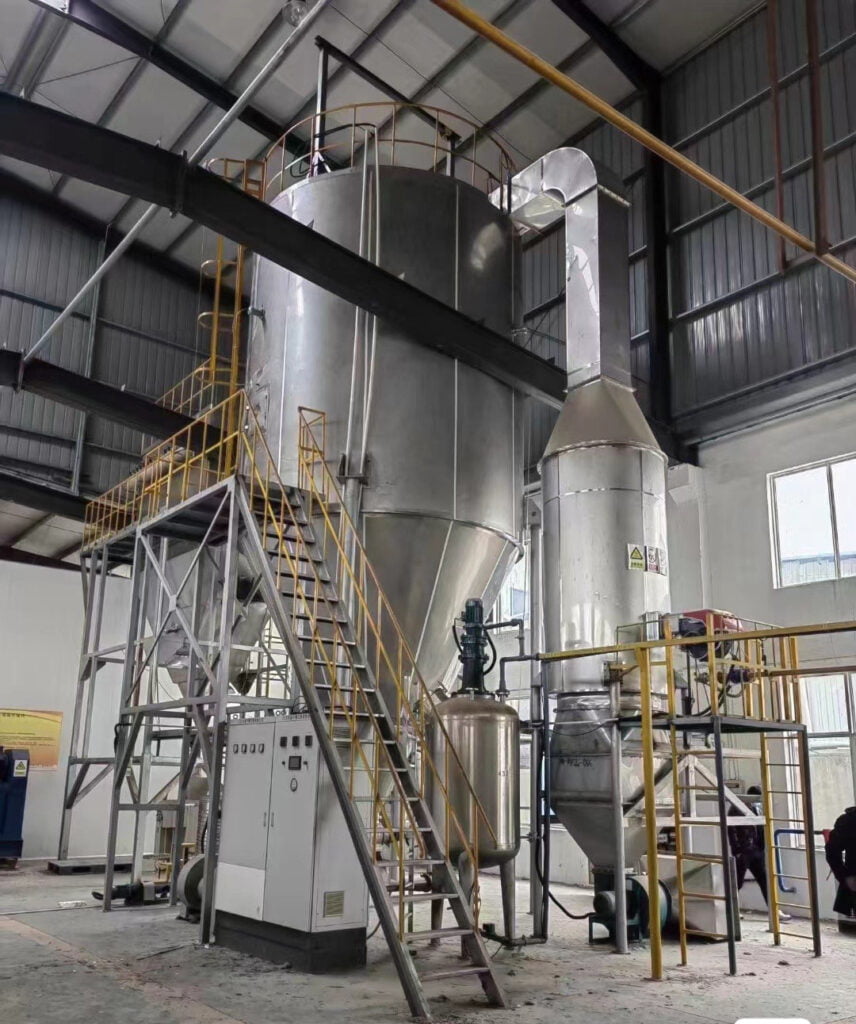
Как работают распылительные сушилки
Давайте обсудим принцип работы распылительной сушилки.. Наиболее распространенные распылительные сушилки состоят из нескольких ключевых компонентов.:
- Система распыления
- Сушильная камера
- Поток горячего воздуха
- Система сбора
Вот как эти компоненты работают вместе:
- Приготовление корма: Компоненты смешиваются для получения жидкого корма., регулировка вязкости и гомогенизация смеси.
- Распыление: Жидкость закачивается в распылительную насадку или вращающийся диск., где он распыляется на мелкие капли.
- обезвоживание: Капли подаются в сушильную камеру., где они быстро высушиваются потоком горячего воздуха. Температура и скорость потока горячего воздуха тщательно контролируются для достижения желаемого размера частиц., морфология, и остаточная влажность.
- Система сбора: Высушенный порошок собирается системой, обычно используют центробежные силы с циклоном или рукавным фильтром., и может быть упакован или подвергнут дальнейшей обработке.
Ключом к распылительной сушке является быстрое испарение капель жидкости в потоке горячего воздуха.. На скорость высыхания влияет несколько факторов., включая размер капли, температура, скорость воздуха, и влажность продукта. Контроль этих факторов обеспечивает последовательное, высококачественный продукт.
Типы распылительных сушилок и их применение
Существует несколько типов распылительных сушилок., и выбор зависит от свойств жидкого сырья, желаемый конечный продукт, и требуемая производственная мощность.
- Роторное или центробежное распыление: Использует вращающееся колесо для распыления жидкости на капли.. Этот тип распылительной сушилки универсален и может работать с продуктами с высокой вязкостью..
- Распыление сопла под давлением: Использует насос высокого давления для создания постоянного, однородный порошок. Обычно используется в пищевой и молочной промышленности..
- Двухжидкостное распыление сопла: Использует газ (обычно сжатый воздух или пар) распылять жидкость. Этот тип насадки часто используется в пилотных сушилках..
- Комбинация распылительных сушилок и псевдоожиженного слоя: Интегрирует псевдоожиженный слой с распылительной сушилкой для удаления небольшого количества влаги или охлаждения продукта..
- Закрытый цикл: В качестве сушильной среды вместо воздуха используется азот., подходит для продуктов, подверженных окислению или когда растворителем является органическая жидкость.
Преимущества распылительной сушки
- Гибкость: Распылительная сушка позволяет производить порошки из широкого спектра жидкого сырья., что делает его экономически эффективным для различных продуктов, таких как пищевые ингредиенты., фармацевтика, химикаты, и косметика.
- Превосходное качество продукции: Этот процесс обеспечивает однородный размер частиц и стабильность., что имеет решающее значение в таких отраслях, как пищевая, фармацевтика, и косметика.
- Сохранение активных ингредиентов: Подходит для отраслей, где сохранение активности и эффективности активных компонентов имеет важное значение..
- Универсальность: Может быть настроен для различных жидкостей и суспензий., позволяет использовать разнообразный ассортимент порошков.
- Снижение загрязнения: Помогает уменьшить количество бактерий и других микробов, важен в пищевой и фармацевтической промышленности.
Промышленное применение распылительных сушилок
Технология распылительной сушки универсальна и применяется в различных отраслях промышленности.:
- Еда: Используется для приготовления растворимого кофе., чай, сухое молоко, яичные продукты, детская смесь, и многое другое. Он сохраняет вкус, аромат, и цвет, сводя к минимуму загрязнения.
- Фармацевтический: Используется для создания порошков., гранулы, таблетки, и инкапсулирование активных веществ.
- Химическая: Используется для катализаторов, пигменты, моющие средства, и сушильные растворители и другие химические растворы.
- Сельскохозяйственный: Используется для корма животным., удобрение, и пестициды.
- Биотехнология: Используется для рекомбинантных белков., вакцина, и другие биофармацевтические препараты.
- Относящийся к окружающей среде: Используется для очистки сточных вод., твердые отходы, и загрязнение воздуха.
- Косметический: Используется для производства косметических порошков и средств личной гигиены..
- Материалы для литий-ионных аккумуляторов: Развивающийся рынок производства порошков для катодных и анодных материалов для аккумуляторов электромобилей.
Недостатки распылительной сушки
- Ограниченная вязкость корма: Только сырье с вязкостью ниже 500 сантипуазы можно сушить, требующее разбавления некоторых кормов.
- Высокие капитальные затраты: Дорогое приобретение и эксплуатация из-за высокой скорости испарения..
- Высокое энергопотребление: Потребляет много энергии на нагрев воздуха и распыление корма..
- Эксплуатационная безопасность: Требуются системы взрывозащиты и системы пожарной безопасности из-за риска возгорания..
Несмотря на эти недостатки, окупаемость инвестиций в технологию распылительной сушки значительна, и постоянные инновации смягчают многие из этих ограничений..
Как сделать распылительную сушку жизнеспособной для вашего бизнеса
Выбор правильного оборудования и поставщика может оптимизировать затраты и выгоды.. Инновационная технология распылительной сушки., например, высокоскоростные ротационные распылители с технологией магнитных подшипников., предлагает гибкость и низкие эксплуатационные расходы, эффективно окупаем вложения.
Заключение
Распылительная сушка — широко признанная технология, имеющая многочисленные преимущества перед другими методами сушки.. Хотя он имеет свои сложности и высокие технические требования., преимущества часто перевешивают недостатки. Тщательное взвешивание «за» и «против» поможет определить, подходит ли распылительная сушка для вашего применения..
Дополнительную информацию о сушильном оборудовании, посетите наш Серия сушки, Кондуктивная сушилка, и Сушилка для переноса горячего воздуха страницы. Какая бы помощь вам ни понадобилась, пожалуйста, не стесняйтесь обращаться к нам по WhatsApp

